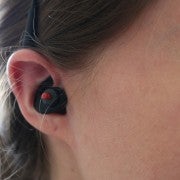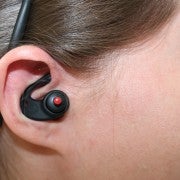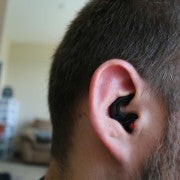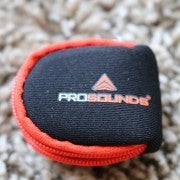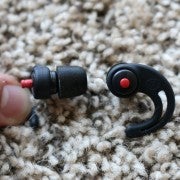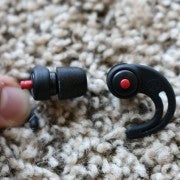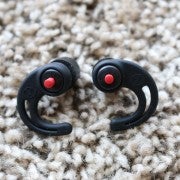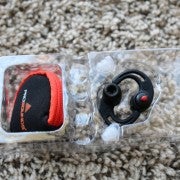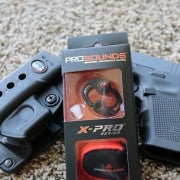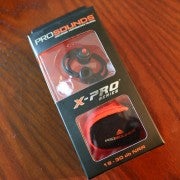High-volume induced hearing loss is considered a high-priority national health issue. Within the shooting community, its a battle we are constantly fighting, always pushing for suppressor usage (which are not always legal), teaching people about the value of ear pro, and instilling good habits in our fellow shooters.
At our detriment has been the fact that hearing protection always comes at a cost. Its a singular issue or combination of bulk, high-cost, ineffectiveness, weight, etc. Few solutions have been user and cost effective until the last few years. Since then, a bevvy of new products have helped shooting and other industries alike combat long-term hearing loss with solid offerings.
Pushing the innovation boundary today is ProSounds with their X-Pro low-profile in-ear multiple-setting ear-plug. ProSounds sent us one of their first production X-Pro sets for review. They are a unique set-up, using push-click valves to open and close the plug for clear communication and maximum hearing protection, respectively.
Author’s Note: Usually, the TFB Staff takes time with a project on a review, often across multiple months and shooting sessions to ensure we capture all the relevant details and quirks of a product. ProSounds sent us the product and requested an expedited review as part of their KickStarter campaign. We obliged, and captured all that we could over a heavy weekend of shooting and used multiple shooters and personnel to capture opinions.

Unboxing & First Impressions
Packaging is an attractive unit. A nice combination of black, orange, and silver letters it will do well on a shelf. The package shows the two earplugs with foam inserts attached, the two “medium” silicone inserts, and the small included carry pouch. Labeling is in subdued grey, with the normal uses for hearing protection called out and amusingly, ProSounds added “sleeping/snoring” to the list.

The packaging claims a total Noise Reduction Rating (NRR) or 19-30 dB, which is impressive, as most plugs are around 24-26, which makes the plug nearly 100% more effective than standard “cheap” foam inserts. Opening the top, the contents slide out easily, with the two plugs within easy reach. The case is in the bottom, filled with the other two foam tips, but was missing the second set of silicone tips (I will chalk this up to being the first production packaging run).

Immediately, the clickers for the hearing valves stand-out. They are a red stem on an otherwise matte black and uneventful ear plug. Clicking them is reminiscent of a click-pen, with nearly identical tactile sensation. However, the stems do not show any difference in height in either position, so it was difficult to tell if they were in the open or closed position without having them installed in the ear.
Insertion into the ear was uneventful. As always with foam, one needs to roll it and crush it down so that it can expand correctly in the ear canal. The foam was soft and pliant, but quickly springs back to shape. After insertion, it only took about 5 seconds for the plugs to seal up. A welcome surprise.

The silicone ear traps are longer than expected, but due to the soft silicone are easily maneuvered within the ear to a comfortable position. They are not fixed to the main plug body, held in place by only tension on the plastic body of the valve– I would like to see at least a detent ring that keeps them from moving laterally during long-term wear. However, this does make them easy to remove from the base plug if the user does not like the keepers.
At the closed position, the plugs do their job well. While difficult to put an SPL meter inside the ear canal, having been around and selling sound as part of my career, 30 dB is not an unjust claim. Using common test of hand-clapping and the wife speaking, I found the plugs an excellent justification to not hearing her.
But, the secret sauce is in the second position on the valve, or “open” as I am calling it. When clicked open, sound reduction is reduced itself, allowing generally clear sound to flow into the ear. Now, it’s not natural sound (as the plug is screwing with the geometries and reflection of sound in the ear), but its easily do-able for a long-day. Speech as low frequencies is slightly muffled but high frequencies are generally clear (dang it, my wife’s voice is in the higher frequency range). I would put NRR roughly at 10-12 dB in the open position.

At the Range
The plugs were taken with me to testing at my local indoor range while I worked on T&E firearms also sent for review. To ensure full testing, the X-Pro’s were inserted prior to entering the store and left in the open position. Speaking with the employees (most are a familiar face, considering I’m at the range 2-3 times a week), the open position was good enough for daily communication, but the stem got in the way during a phone call. It was usable, but an annoyance.
Heading into the range, I found ProSounds’ claim that “so comfortable you will forget about them” true and walked into a Mosin Nagant carbine going off full-bore. Ouch! I forgot to click them into the closed position. After a quick fumbling, the valve was closed by the time the shooter racked the action and let the next round loose.
To that fumbling, the stem is generally easy to access, but once in the ear, the valve requires some force to push in, which can disturb the seal partially. It only took a second or two to re-seal completely, but it was noticeable none-the-less.
During shooting, the plugs held up nicely and after a few hours of spirited firing, my ears were still comfortable and there was no extra ringing in them, outside my personal idiocy from the Mosin mentioned earlier.


Compared to the Surefire “EP” Series
I have been a long-time user of the SureFire EP series ever since I was introduced to them by Scott Wilson at Surefire when they were first released. I loved their comfort, low-profile nature, and effectiveness.
Looking at the two offerings the SureFire is the easier to use versus the X-Pro as its flange is built-in and noise reduction is instantaneous and does not require physical manipulation. However, this comes at a cost. The X-Pro, when in the open setting, is clearer communication and feels less intrusive on the sound quality. Both are nearly indistinguishable when both are fully closed. The Surefire requires the user to insert the attached plugs and the X-Pro requires one to click the valve closed.
On the comfort side, the SureFire is noticeably lower-profile, as it does not have the click-stem protruding from the base, but when left open, if the valve cover is not maneuvered to a comfortable spot, can be quite irritating. As such, the SureFire is easier to use with a cell phone, as the stem gets in the way with the X-Pro, but as mentioned earlier, the sound muted compared to the X-Pro.
The X-Pro does get a nod, as it can remove the ear retention piece and use just the plug if one does not like the feeling of the locking mechanism. However, the SureFire beats it out by offering small sizes that do work with small ears and canals. The X-Pro, as tested, only worked effectively on large and medium ears.
At retail cost, the SureFire has the clear upper hand. They are $17.95 versus the expected retail for the X-Pro at $25 according to their KickStarter campaign, but those participating in the KickStarter campaign will be able to pick them up for $17 – a .95 advantage and typical market pricing for these products is below the retail anyway.
I personally could not pick a clear winner between the two offerings. Both, to me, have their intended usages and would serve the shooter well. It will be up to the user to pick what they value between the two offerings – clarity of speech, user-friendliness, and flexibility.

The Good:
- Comfortable, adjustable, and generally non annoying for a full day’s wear at the range or at work.
- The click motion does work and one can definitely tell
- SRR is about 30 dB, which is suitable for single-layer hearing protection while shooting.
- Washable, not disposable.
- Case is large enough to easily hold the tips. (And I applaud the orange, which makes finding the small case easy in a bag)
- Low-profile. Does not impede or risk coming off with a good cheek weld.
- Also works with double-hearing protection comfortably
The Notable:
- Even with the valve deactivated, its not quite full & natural sound, but it is functional.
- ProSounds claims they are low-profile and usable with a cell phone. The valve makes using a cell phone difficult, but not impossible.
- The clicker is intuitive, but not as easy as shown in the Kickstarter video. It requires some finding and and force to press.
- The in-ear keeper is not held on to the earbud through a detent or similar. It can be moved in and out on the base plug, or the plug can be worn without the ear keeper.
The Bad:
- Does not fit small ears, at all, even without the ear keeper and medium silicone tips. Needs a small-ear foam plug kit.
- Case does not have separate pouch for holding unused/replacement tips.
- While the tactile feeling of the button is much like a click-pen, there is no difference in the stem’s position when at either setting. Would like to see the stem move so that the shooter can feel the position quickly.

Final Thoughts:
The ProSounds X-Pro is a compelling offering. It works as advertised and the sound reduction is solid for the shooting sports. The push-button valve is a solid piece of innovation and engineering, and the ear holder is comfortable.
I, personally, would have liked to have seen those “finishing touches” that would come on a mature product, but don’t let my quibbles dissuade you from looking at these in earnest. Across the two days of shooting, they worked and the quick-click sound reduction was appreciated, especially when I wasn’t paying attention to other shooters on the line.
Retail is $25, which is more than its closest competitor (the SureFire “EP” hearing protection series), but at the KickStarter price at $17, they are in-line with the SureFire’s current market price. With the funding ending soon and the risk on delivery low (I saw the final packaged version, so they are ready to produce), the X-Pro is a solid choice.
You can see the KickStarter Campaign, contribute, or just root them on here.

 Your Privacy Choices
Your Privacy Choices

